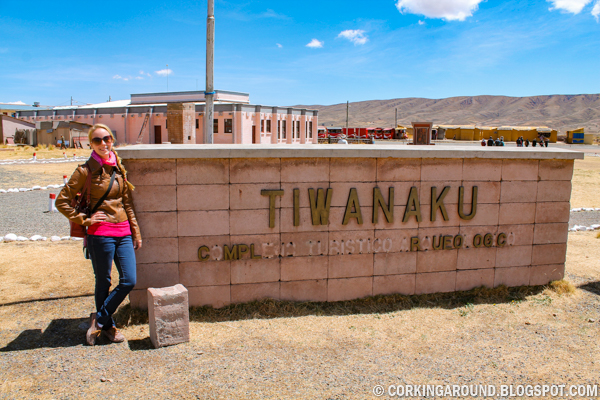Bolivia's City of Tiwanaku
When it comes to South America one of the first countries that tends to pop up in conversation is Peru and its breathtaking 15th century Inca site, Machu Picchu. Though I have yet to visit it (hopefully one day!), I trust it’s as amazing in person as I read about. However, I feel its majesty tends to overshadow the existence of many other pre-Hispanic sites spread over the continent. One such site is Tiwanaku, a UNESCO World Heritage Site which is pre-Inca and nearly a millennium older than Machu Picchu.
Located near Lake Titicaca on Bolivia’s Altiplano at an altitude of 3850 m (12,631 ft), Tiwanaku flourished into a city between 400 A.D. and 900 A.D. in what is now the Province of Ingavi, Department of La Paz. Much of the ancient city, which was built from adobe, is overlain by the modern town. Fortunately, the stone buildings from the ceremonial center have been preserved in archaeological zones.
What remains of the city still spans over a great deal of land and contains architectural structures that correspond to different periods of cultural accessions. During our tour some of the structures we saw were the Pyramid of Akapana, the Gate of the Sun, the Temple Semi-undergound, and Pumapunku. These were all part of the public and religious sections of the city.
The most imposing structure in Tiwanaku is the Pyramid of Akapana. Today it resembles more of a hill than a pyramid, but it was originally covered by sandstone and andesite (a fine-grained volcanic rock) and topped with a temple. It had seven superimposed platforms with stone retaining walls that rose over 18 m (59 ft) high. Talk about impressive! Today only the lowest of the walls and a few intermediate in height remain intact.
North of Akapana is the sunken Temple of Kalasasaya that archaeologists believe was used as an observatory. Unfortunately I didn’t take any close range photos of the temple itself as I wasn’t very organized with my travel photography when I first began touring the world. However, I did snap a few photos of the Gate of the Sun, which is encompassed by the temple and is one of the most important art specimens from the city.
The gate itself is 2.8 m (9 ft) high and 3.8 m (12.5 ft) wide and was carved from a single slab of andesite; the niches on either side of the door are called Hornacinas. Above the door frame is what many have interpreted as an agricultural calendar. There’s a carving of a Staff Deity from the Chavin culture on a platform with a staff with condor heads in each hand and wearing a feathered headdress. Birds surround the deity and human faces line the bottom row of the panel.
I did manage to get some birds-eye view photos (or, rather, one of my best friends took these for me!) of the Temple of Kalasasaya. As you can see, this sacred structure was rather large at 130 by 120 m (426 by 394 ft). You can probably just barely make out the location of the Gate of the Sun in the upper left corner of the temple to the left of my elbow. The interiors of the perimeter walls have severed stone heads protruding from the sandstone likely as a reminder that the court within the walls served as an area for religious ceremonies. And yes, human sacrifice was a part of the culture as was characteristic of many cultures at the time.
The Semi-Subterranean Temple also has stone heads protruding from its walls. Its sunken court is 28.5 by 26 m (93.5 by 85 ft). Though not pictured, this temple has the “Bennett Stela” which, at 7.3 m (24 ft) high, is the tallest surviving stone sculpture from any ancient Andean culture.
Last, but certainly not least of our tour, was Pumapunku, another temple mound that is 167 m by 117 m (549 by 383 ft). What’s fascinating about this particular site is the amount of engineering that went into its construction. Pumapunku contains two spectacularly large red sandstone rocks within the temple grounds. The largest is 7.81 m (25.6 ft) long, 5.17 m (17 ft) wide, and weighs about 131 metric tons (~288,810 lbs). The second largest is 7.9 m (25.9 ft) long, 2.5 m (8.2 ft) wide, and weighs about 85 metric tons (187,393 lbs).
Even more remarkable is that these and other red sandstone blocks were transported up a steep incline from a quarry near Lake Titicaca about 10 km (6.2 mi) away. Other smaller andesite rocks were quarried from the Copacabana Peninsula about 90 km (56 mi) away. Archaeologists haven’t been able to finally determine how the people of Tiwanaku transported such heavy rocks from such a distance. The most agreed upon theories involve 1) using llama skin ropes and 2) using ramps and incline planes.
And if that wasn’t enough to impress you, the Tiwanaku civilization had the technology to cut each stone so finely and precisely to create interlocking joints that not even a razor blade can fit between the stones. This type of stonemasonry is considered to be far in advance of even the Tiwanaku’s Inca successors. Imagine that! What we can do today with lasers and metal tools the Tiwanaku did with stones and sand.
So, while this ancient city might not have the lush, green mountain views of Machu Picchu, it remains just as rich in history. Moreover, it’s a look into a culture that existed before the Inca empire that is rarely mentioned in history books. Next time (or the first time!) you’re in Bolivia I highly recommend making time to see this ancient city.

















Comments
Post a Comment